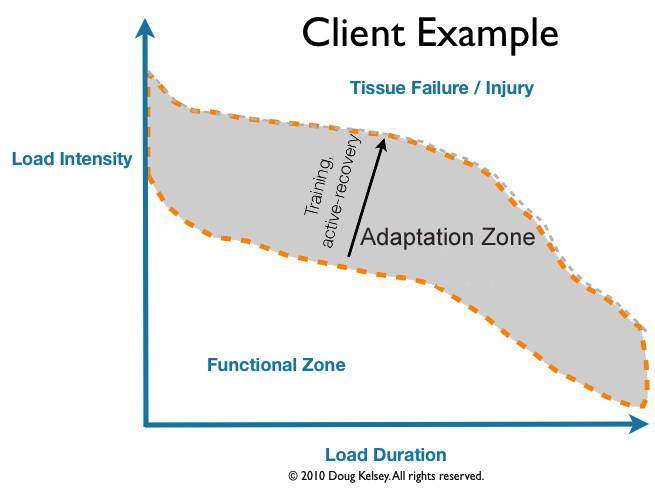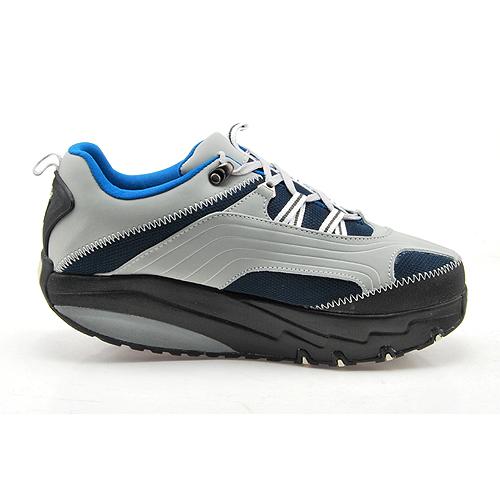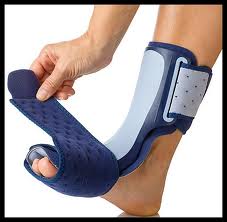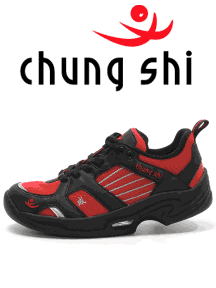
In case you missed Part I, I created a new problem for myself along the way to grabbing the basketball rim again: plantarfasciitis or more accurately, plantarfasciosis.
I’ve found that with any injury that is self-induced, the first thing to do is breathe. Stop blaming yourself or telling yourself how stupid you are or asking something like, “Why me?”
Yeah, I do my fair share of whining and complaining. That’s part of the process but it has to stop at some point in order to move forward.
You can’t build your tomorrow by reliving your yesterdays.
It is what it is. What’s important is learning from the process and getting started on rebuilding your abilities.
I mentioned in my last post that I had a few emotionally charged events that I reacted to by walking; processing the emotional loads by increasing my physical loads.
This is a really common way to deal with stress. In fact, many of my clients over the years, especially those who loved to run, found themselves in a tight spot because the very thing they used to keep the “wheels on the wagon” turned into an injury which in turn completely disrupted their lives.
So, to add to the emotional load, Spencer, our Dalmatian and my best buddy, died. Since I had just made a poor choice in walking off my angst a few weeks earlier, that option wasn’t on the table. So I did what I should probably have done when Abby died and I busted my bike, and all the other stuff happened.
I let the feelings in.
I sat still, closed my eyes, and breathed in the pain, the sadness, the frustration until it filled me up and I exhaled letting it go. Over and over. I let myself wallow in it. I fought the cultural stereotype I had (and still have to a degree) in my head that as a man, I should bounce right back, not shed a tear, be super strong wearing a force field like a common vest. Nothing gets in and show no fear.
And for sure, don’t talk about it.
Be as dishonest as possible.
This is how I handled things in the past. In fact, one of my graduating senior classes at the University of Oklahoma gave me a surprise gift at the end of the year: “Stone Cold Kelsey” – not exactly what I had in mind to be known for but it was true.
 Awarded by the Class of 1998
Awarded by the Class of 1998
I had a hard time acknowledging and sharing emotions. I felt things deeply but had no clue what to do with those feelings. I’ve since “thawed”, some, but am still a work in progress.
I let myself feel the emptiness of the house; where Spencer used to be, follow me, “talk” to me. The routines he and I had together. I didn’t stop the sadness with busy work – like walking or cleaning or whatever. Instead, I chose to feel what I knew would be a bad feeling.
My point is to turn toward the pain and let it in. I know. It’s about the last thing you want to do when something bad happens; when you lose someone or something you love. But, in my experience, and from what I’ve learned from others, you have to feel the pain to keep it from staying with you forever.
The way out is through.
Onward…
So, let’s talk about how I’m dealing with this stinkin’ foot injury.
Principle #1 – reduce any additional offending stress – use crutches if necessary
When I woke up that first morning and noticed the pain and it didn’t subside a lick in a few hours, I knew I should use crutches.
But, really? Crutches?
The force created by my body weight was simply more than my foot could withstand. I had to get the force down to a point where walking was comfortable if I wanted to move the healing and recovery along as fast as possible.

This brings up a fundamental concept of function and tissue healing that I go over in detail in the Runner’s Knee Bible – Load Tolerance.
In the graph above, the “Functional Zone” represents the loads and durations that you can withstand; activities of daily life as well as exercise, sports, hobbies.
As the load and duration increase, you move into what I call the “Adaptation Zone” – this area is over your ability but not so much so that you hurt or can’t recover from the event.
When you cross over the “Adaptation Zone”, you then end up in the land of “Tissue Failure / Injury”.
So, for me, my Adaptation Zone is quite narrow. The right kind of training will expand the zone so I had to figure out a way to do this.
Then I remembered that I had some shoes in the closet that might work.
One of the benefits from testing lots of things is that sometimes they come in handy later on. The shoes were MBT shoes and Chung Shi shoes.
The MBT shoes have a monstrous soft cushioned sole. The manufacturers claim that the soft sole causes you to be less balanced so  you use more muscles when you walk and you can “tone” your butt which is nonsense but it sells shoes to people who are looking for a shortcut for a more muscular butt.
you use more muscles when you walk and you can “tone” your butt which is nonsense but it sells shoes to people who are looking for a shortcut for a more muscular butt.
I bought them to test out for a client who had degenerative joint disease of the knee. I thought the massive cushion on these shoes might act like an airbag for your feet and reduce the impact loads of walking and thereby reduce his knee pain.
It worked. He could walk comfortably in the shoes (this wouldn’t have worked if the force reduction was less than what he needed). They do make you feel a little unstable though so there’s a period of learning how to walk in them.
I figured if the shoes could reduce load for my client, maybe the same shoes could reduce the load on my foot and make walking a less painful or even painless experience. If so, I wouldn’t need crutches.
If I wore the shoes and still had significant pain, then I would have to use crutches to remove more load from the foot.
I laced up the shoes and walked about ten feet.
I noticed some mild pain. On a scale of 1 to 10, where 10 is excruciating, I rated the pain about a two. I could walk normally, go up and down stairs. I felt quite good overall.
So, I decided to skip the crutches and wear the MBT shoes. And then I had another idea.
What if I used the shoes as my rehab tool? What if I used something that normally hurt, like walking, as a means of healing my injury? Would that work? I had a sense it might.
Principle #2 – protect the tissue from further injury – avoid stretching the injured area, use bracing and taping as needed
At night while I slept, I used a splint to hold my foot in a more neutral position. I used this splint from Walgreens and it worked well (sometimes referred to as a Tension Night Splint – an effective aid for pain relief). By doing this, the pain in the morning was much less. I made the mistake a couple of times of applying the splint with too much force which lead to a painfully numb foot in the middle of the night. Now, it’s not comfortable really to wear something like this when you sleep but I’ve found it seems to shorten the recovery time if you do.
As as far as stretching is concerned, this seems to be most effective for any associated trigger points within the plantar muscles but you have to be careful how aggressively you stretch (and other techniques like rolling your foot on a tennis ball, etc are essentially trigger point treatments).

Principle #3 – use pain relievers as needed – this would include both pharmaceuticals and other techniques
Since my foot hurt mostly when I placed weight on it and I could reduce the force with footwear, I didn’t use pain medicine. I did use kinesiotape on the bottom of my foot and up the outer aspect of the lower leg for the first four days. It just felt better overall when I wore it. After about four days, I didn’t think I needed it anymore.
Principle #4 – identify a comfortable weight bearing limit
Had my experiment with the MBT shoes failed, I would have had to test my weight bearing tolerance for things like single leg squat, rising up on my toes (heel raise), and walking. This is the standard set of tests I use with clients with plantarfasciosis. I like to know for certain how much force is an acceptable level. For me, I was okay with not knowing exactly.
For the squat and heel raise, I use either a Total Gym (TG) or a Total Trainer (TT) (there may be other devices as well but these are the only two I’ve used).
The TG and TT are variable incline exercise devices that use a percentage of your body weight for resistance. I go over the process for testing single leg squat for knee pain in my book, The Runner’s Knee Bible. Testing load tolerance for foot pain is very similar to that – you’re using different movements but the mechanism is essentially the same. The goal is to identify the upper limit of force. Once you know that, then exercise becomes much easier to figure out and turns into a therapeutic tool.
Principle #5 – exercise through three planes of motion within the comfortable weight bearing limit
In my case, as long as I was in the MBT shoes, my foot felt fairly good; not “normal” but not bad enough that it altered my function or form.
However, the MBT shoes are not designed for side to side motion or sudden turns. Walking / slow to moderate running is fine. For exercise that involved changing directions, I had to try another pair of shoes. If this failed, then I would have to do something different in order to rebuild the strength in my foot.
The shoes I used were Chung Shi shoes. These shoes have a cushion effect but not as much as the MBT shoe and they’re more stable allowing change in direction, pivot, etc.
The good news was that I also felt okay in these shoes which meant I could use the Fusion Elements as a way to rebuild my foot strength and tolerance.
The Elements (exercise routines I designed named after the elements in the periodic table) require you to move your body through multiple planes of motion, balance on one leg, shift weight from one foot to another, pivot, move with speed. Normally, these types of movements come into the rehab program much later because the loads are usually too great.
But with the Ching Shi shoes, I had no problem at all which meant that the Elements would work for me. This saved me an enormous amount of recovery time compared to a more “conventional” approach of exercise off the foot (theraband, towel crunches, stretches, etc).
Principle #6 – re-test the weight bearing limit and adjust the training
This is probably the most difficult part of the process when you don’t have the proper tools. I had a TT at my house but it’s now at the ActiveAge Studio. So, to find out how much force my foot can withstand, the procedure is not as precise as I would like it to be and as a result, there’s a chance I could overload my foot and set myself back a week or two…or more.
At some point, I had to stop using the MBT / Chung Shi shoes and get back into my regular training shoes.
At about the six week mark, I was able to use my regular shoes (Converse) for the Elements but running still provoked symptoms after I finished the running intervals. I felt fine while running.
The symptoms lasted for more than 48 hours so I had to go back to the MBT shoes for a few times and try again.
What I found was that I could run for shorter intervals in regular shoes with a mild increase in symptoms after I finished that lasted less than 48 hours. This told me I was on the right track. I would have to keep track of the running intervals and very gradually increase the duration.
Not All Pain Is Bad
In my case, I use pain and stiffness as a guide for recovery. I don’t get too upset if I do some running or an exercise and my foot hurts for a day or so. As long as the symptoms subside with about 48-72 hours and after that I can move normally, I’m fine with it. It’s a normal response. But I understand that not everyone looks at pain / symptoms this way.
Pain and stiffness in the morning is another marker I use to help me decide whether I’m ready to progress my routine. Right now, I have a mild degree of pain that lasts for a few steps first thing in the morning. I won’t start jumping routines again until I have two weeks of no pain or stiffness in the morning. I don’t know how long that will take but as long as I’m seeing some progress, I’m fine with the timeline.
Keep in mind that this process is working for me because wearing the MBT / Chung Shi shoes allow me to move comfortably. I was able to expand the “Adaptation Zone”. If I had moderate to significant pain in these shoes, I would have had to do something else. So, my solution is, well, my solution. It’s not intended to be copied by anyone else since their situation may be entirely different.
Why Not Use Conventional Approaches?
Frankly, most of them don’t work. It’s too much of a roll of the dice for me. Things like stretching, poking, rubbing, rolling, ultrasound. electrical stimulation, ice, among others are largely pain relief techniques. At the end of the day, the issue boils down to this: how much force can you produce and absorb? To the extent these techniques help you produce and absorb force, great. But the problem is that too often pain relief techniques are all you get with very little functional training of the foot and leg.
I still have some work to do to get back into my jumping but things are headed the right way. And, of course, I may run into another setback and if I do, I’ll deal with it. In the meantime, I’ll keep moving ahead.






